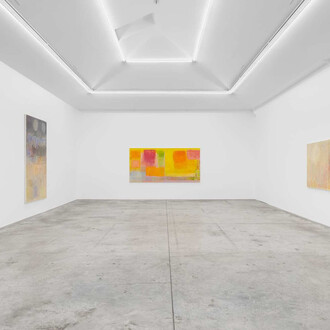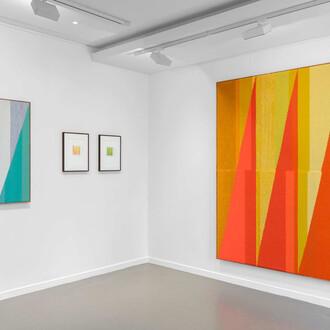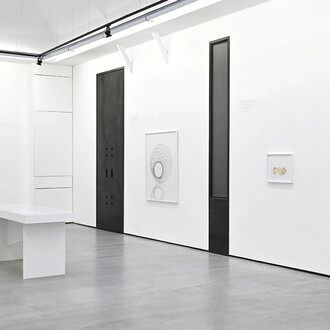Paintings, sculptures? Objects, ceramics? Justin Adian’s works, presented for the first time in a solo exhibition in France, are difficult to define at first glance. It takes a moment before you can read past their apparent ambiguity. Whether they look like marouflage paintings, volumes hung on a wall, or delicious, abstract, dynamic works, the pieces that Justin Adian creates joyfully communicate a “can-do“ spirit. And in fact, the artist spends long hours in the studio, composing and recomposing, constructing, deconstructing, reconstructing, bringing several forces into play.
These misleadingly soft shapes, made initially from cushions pressed into chassis, are then covered with stretched canvas. Naturally, in line with the tradition of American sculpture, they recall the works of Robert Morris, Richard Tuttle, Lynda Benglis, but also Franz West and even Eva Hesse. Dancing and active, they also conjure up Ellsworth Kelly‘s paintings. However, if you look closely, you can sense a tension and a direction within the composition. And Justin Adian accentuates it in the way that he hangs and displays them.
“I generally start with drawings to get an overall idea of the structure. My work, though, springs from a rather organic process that gives me freedom in assembling the various pieces. When I bring these elements together, I accept whichever way they position themselves. Afterwards, I move on to the painting stage, painting each object individually as a surface.“
His compositional research hints at Lyubov Popova and Kazimir Malevich. And while Justin Adian told us that his art history classes did indeed cover these giants, for him they are more affinities than direct influences. He has great admiration for Malevich‘s Black Square. And like Malevich, he too works with the invisible space between his “objects“.
The word object is indeed one that Justin Adian frequently uses, even if his favorite phrase for working is the one devoted to painting. And so, a piece may receive anywhere from four to seven layers to give it transparence and depth. Sometimes he may give a piece crackled finish for a ceramic look. This gives rise to other ambiguities to be chased in reading his work: a tension coupled with a delicacy, if not to say fragility.
We can anachronistically imagine him at work in his Brooklyn studio, busying himself like a medieval goldsmith. Although the term is a rarity in today’s language of contemporary art, Justin Adian literally “delights” in perfecting his surfaces and compares his various layers to makeup and cosmetics. He says, “It makes me feel like I’m actually creating skin. While other paintings may suggest landscapes, particularly the horizontal ones, my own work is actually different, in a hidden way. It’s fairly narrative because it has all these stories that I tell myself.”
Some of the titles of his oldest pieces were rather amusing and gave them an off-beat flavor. Similarly, his use of industrial paint with an occasional additional layer of spray paint to heighten the sheen distances him from the caricatured gestures of painters. He is very physical with his work, particularly the largest pieces: stretching the canvas, standing back to gaze at it from a distance, then moving up close to it. In this first showing ever of his ensemble of new works titled Waltz, new shapes spring to life as if inspired by musical notes, or as the fan of rock and punk music puts it, “from some other type of language”. Playing off each other as well as the space in the gallery and the visitor’s gaze, in the end, they make up a score just waiting to be played.
Text by Marie Maertens
















